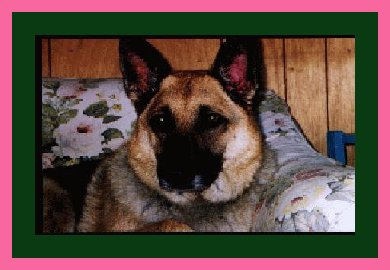
Sheba
1992 -2003

After the first world-war, all the Alsatians recorded in the Kennel Club Stud Book in 1919 were bred and born in France. They were known in that country as Berger d'Alsace, or Alsatian Sheep Dog, so that the first importations, save only the few that came to England prior to 1914, were correctly described as of Alsatian breeding.
It was not until two or three years later that the Germans claimed the breed as identical with the German Shepherd Dog and there is little doubt that their claims would eventually have been admitted, had they maintained the standards set by the great Rittmeister von Stephanitz.
They drove a thriving export trade in their dogs for some years, until the best of their stock had departed to U.S.A., to Great Britain, to China, to Japan, and many other countries. Thereupon they changed the standard of the breed, and under various excuses reduced the size of their old noble Siegers and Siegerins, until they became small and insignificant.
Undoubtedly, it was the high intelligence of the Alsatian that first attracted attention. The Alsatian has powers of scenting that no bloodhound can better. His appearance has a look of nobility unsurpassed by any other breed. The Alsatian in the private family is a companion and a guard dog. He is the ideal patrol dog and will guard his master with his life. To the police he is a detective and a protector, and he has taken his place in the "guide dogs for the blind" movement, but shares it with other dogs as blind men and women are of different heights. Little men require smaller dogs and tall men work better with larger dogs.
One cannot leave the working qualifications of the Alsatian without recording the work done in connection with the use of the dog for leading the blind. The main credit for this work must go to Mrs. Eustis, an American lady who established herself with a kennel of Alsatians in Switzerland and there became interested in training the dog for leading men blinded in the first World War.
She with the assistance of Mr. Humphrey established the movement known as the "Seeing Eye," which undertook the duty of training both Alsatian and blind man in such a way that the dog could act as the eyes of the man. The Germans had already done a certain amount of work in the same connection, but here again they have been left far behind in the technical excellence of the work accomplished by British-bred Alsatians in this country and American-breds in the U.S.A.
 Click here for more of my dog's Pics
Click here for more of my dog's Pics

